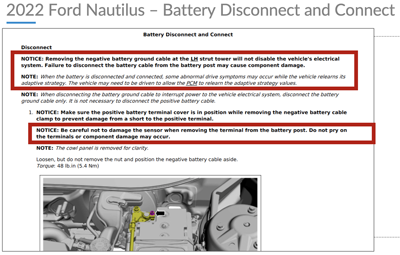During a recent collision industry seminar I was teaching, I asked if there were any technicians in the class, and several people raised their hands.
I asked them: “If I walked into your shop, and asked you if you research the procedures in the OEM repair manual before you disconnect a battery, what would you say?”
It’s a question I’d like you to consider right now as you start reading this article.
In that class, I heard one tech muttering something quietly, and I asked him what he said.
“I would say if you don’t know how to disconnect a battery, you shouldn’t be working on cars,” he replied.
That’s a fair statement, I told him. But then I took him---and the rest of the class---through the OEM procedures for a particular vehicle, showing him what that automaker states you need to be aware of before you disconnect a battery. Yet I think most of you, like that tech in my class, would acknowledge that no, you’re not researching the OEM repair procedures before you disconnect a battery.

So let’s talk about this. First, one of the things you need to know before you disconnect a battery is whether the vehicle is connected to telematics. This is only going to become more important moving forward as more vehicles are “connected” to things like General Motors’ OnStar or Toyota/Lexus Safety Connect.
What we’ve found is, in some instances, if the vehicle is connected and you disconnect the battery, it may send an alert through the telematics to the automaker to say something happened to this car’s battery. The OEM may in turn contact the customer via text or email, or sometimes even alert the dealership service department to ask them to reach out to that customer.
Your failure to research the procedures prior to disconnecting that battery just created a bad customer service experience.
So before you ever disconnect a battery, determine whether the vehicle is connected, and if so, determine if you need to place it in “service mode” first.
Another consideration is “wait time.” Every automaker I’ve researched says you have to wait a certain amount of time after you turn the vehicle off before you disconnect the battery. It’s not a one-size-fits-all procedure.
For one vehicle, the automaker may say you have to wait one minute, while another may say you have to wait six minutes. I’ve seen some OEMs say after you turn the car off, you have to wait 90 minutes before you disconnect the battery.
There are often other precautions listed in the automaker battery disconnect procedures. For example, you may have to protect certain components. I saw a procedure recently that said you have to have the left front door open when you disconnect the battery. If you don’t, it can trigger some diagnostic trouble codes.

Okay, so you followed the disconnect procedures, repaired and the vehicle, and you’re ready to reconnect the battery. Are you researching those procedures every time as well?
I know the answer to that question because it’s something we ask about in our “Who Pays for What?” survey every year. We found less than half of you (46%) say you’re researching those procedures all or most of the time. While I would say even “most of the time” isn’t good enough, I’m even more concerned about the 41% of you who say you do it "some of the time” or “only occasionally.” And the 13% of you who said “never” are just inviting trouble.
Every vehicle manufacturer I’m aware of has certain procedures that must be done when you reconnect a battery. Some of them may be initializations, like for a one-touch feature on a window or sunroof.
I can tell you I recently saw reconnect procedures for a Ford that said the vehicle must be driven for a certain amount of time and distance so the engine can relearn or reprogram itself. I’ve seen other OEMs say when you reconnect the battery you have to do a steering angle sensor procedure.
At Collision Advice, we recently built a new training course focused just on battery disconnect and reconnect procedures. We found enough content related to this topic to fill more than six hours of classroom instruction to ensure estimators and technicians understand what they need to know.
So now that you’ve read this article, I’m going to ask you again: If I walked into your shop, and asked you if you research the procedures in the OEM repair manual before you disconnect a battery, what would you say?
Oh, and another incentive for taking this important step: The “Who Pays for What?” survey found that among the shops performing the OEM battery reconnect procedures, nearly two-thirds (63%) said they are paid for that labor “always” or “most of the time” by the eight largest national insurers.










Mike Anderson